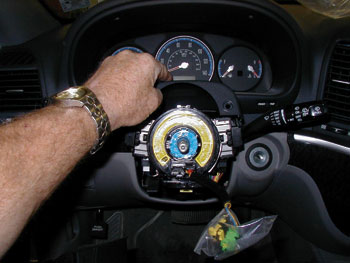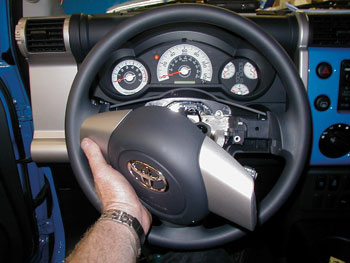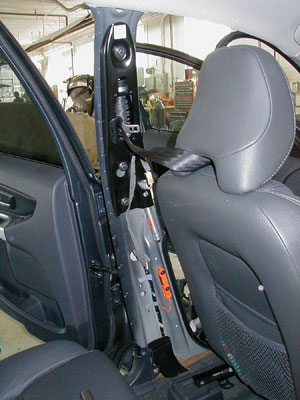These days, the systems have developed into fully enveloping curtains and complete passenger compartment protection. It’s a long way from the original systems offered at unbelievable prices in the late ’50s early ’60s. I found several old repair manuals dating back to those days that briefly (and I mean briefly) mentioned airbag systems. A lot of times it was in the same section of the manual with seat belts. (Passenger safety wasn’t high on the list of priorities back then.) The original airbag systems were sometimes more expensive than the car itself. Surprisingly, they did sell, but whether or not they worked like the companies claimed they would, well, I can’t answer that. I couldn’t find any statistics on early airbag usage; my guess is that they were not that reliable. But now, with modern technology and advanced electronics we have an affordable system that really, really works.
CHEMISTRY 101
Generally, an airbag consists of sodium azide (NaN3) and potassium nitrate (KNO3), which, when mixed together in the right proportions, will produce nitrogen gas (N2) (rocket fuel).
The estimated speed of the bag’s inflation is around 150 to 250 mph as it leaves the steering wheel housing, which takes about 1/20th of a second.
The powder substance that is accompanied with the blast is actually cornstarch or talcum powder. Neither of which is there for the explosion, but rather for coating the bag itself so that the material will stay pliable and lubricated to the point that it will not tear or deteriorate.
CLOCKSPRINGS
It took a new, innovative part to allow the horn and the airbag to be in the same place on the steering wheel. It’s now commonly called the “clockspring.” It’s nothing more than a thin wire tape rolled on its edge that takes on the appearance of a clock main spring. As the steering wheel is turned, the tape either tightens up or loosens its windings.
It’s a good practice when taking off the steering column or removing the steering rack to avoid turning the wheel too far, as it can snap that thin tape of wire. I would advise finding some way to secure the steering wheel and the steering shaft from rotating while it’s disassembled.
DIAGNOSTICS AND INFORMATION
Diagnosing airbag systems is a matter of having the correct scanning equipment and the correct repair procedures. There are several manufacturers that offer a way to count the flashes of the airbag light for diagnostic purposes. (I wish more did the same.) Some manufacturers offer the “read the flashes” method; they also have fewer actual codes. When you look up the code, it may refer you to a four-digit code and a diagnostic tree at that point.
I’ve also seen these two-digit flash codes only be a generic code referring to a certain section of the airbag system. The diagnostic two-digit code may not be able to tell the difference between the driver’s side and the passenger’s side. After looking up the two-digit code, the diagnostics might even ask you to scan the vehicle with a scanner to determine which side it actually is. Sometimes, you can get by with the two-digit codes; a lot may depend on the year of the vehicle.
The older the car, the more likely that counting flashes may work. Determining faults and repair procedures differs from manufacturer to manufacturer, so my advice is to read up on that particular manufacturer’s systems and learn everything there is to know about how it works. 
For me, it’s the scanners that make the difference. I have several dealer-level and aftermarket scanners for working with airbag systems. Some of the scanners are dedicated to only certain models’ airbag systems — European, Asian and domestic. They can be expensive, so you’ll have to weigh the cost of these scanners against how much use you’ll get from them.
The one problem I find with the dedicated airbag scanners is that they get dated extremely fast. A lot of times, the manufacturer has no updates available and whatever years and models that tool covers is all you get. As the years pass by the dust settles on the scanner’s case, never to be opened again. So think about it before you buy a scanner for that purpose. Since I do a lot of business with several body shops, I can weigh the cost with the amount of work that I get referred from them. Without those jobs, I don’t believe it would be a paying proposition for me.
However, as time has a way of changing things, so does the aftermarket. There are some great scan tool manufacturers out there with outstanding equipment and information available to the independent marketplace.
Along with knowing the airbag systems, you’ll also need to brush up on your skills dealing with different interior components — everything from removing the driver’s airbag (special tools may be required) to removing the dash panels for access to the passenger airbags. I’ve even had to replace entire dash panels because the passenger airbag is built right into it. It seems pretty silly to change an entire dash panel because of it, but I only repair the problems, as I’m not the design engineer. 
You’ll also need to work on your upholstery skills. Many manufacturers have installed the side-impact bags into the seats themselves, so now you will have to pull the seat out, and break it down to the foam and frame to replace that airbag.
Let’s not forget about the headliners and seat belt systems. The seat belt system is as much a part of the airbag systems as the airbags themselves. In the early days of airbags, seat belts were not a part of the system, but after many years of testing and development, the seat belt has become an integral part of the overall safety systems in today’s vehicles.
CALIBRATIONS
Adding even more detail to the air bag system diagnostic and repair process is the “Passenger Presence System” (PPS), also referred to as the Occupant Presence System or the Occupant Classification System in some vehicles. For the most part, they are basically the same thing. It is a required reprogram for those vehicles equipped with the system.
On some vehicles, you’ll need certain pre-shaped weights that you place on the passenger seat in order to correctly “zero” or recalibrate the unit. This reprogramming gives the controller the ability to detect whether it’s a child or an adult occupying the seat. If the control module doesn’t “sense” any weight, it won’t command the passenger airbag to engage. (On some vehicles, it uses the weight as a way of determining the speed of passenger airbag deployment.) Failure to program the PPS will keep the airbag light on.













